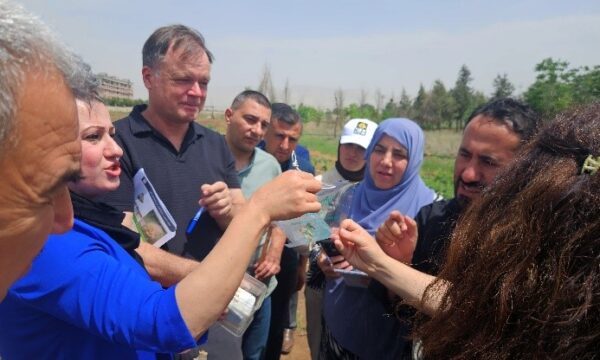
CABI’s Dr Roger Day has shared his expertise on the fall armyworm (Spodoptera frugiperda) as part of a team of researchers who have sought to map the growth and spread of the devastating pest in Australia.
Dr Day, Programme Executive, Action on Invasives, joined lead authors Dr James Maino of Cesar Australia and Dr Olivia Reynolds of both Cesar Australia and the Graham Centre for Agricultural Innovation, who suggest that in Australia, the large spread potential of the fall armyworm will allow it to ‘exploit temporarily favourable conditions for population growth across highly variable climatic conditions.’
The researchers, which also includes those from the International Centre of Insect Physiology and Ecology (ICIPE), Plant Health Australia, the University of New England and the University of Melbourne, say that the fall armyworm would be present in a ‘wide range of grain growing regions at certain times of the year’ but that the expected seasonal activity will ‘vary markedly between regions and years depending on climatic conditions.’
They believe that the ‘window of activity’ for FAW will be longer for growing regions further north, with some regions possessing conditions conducive to year-round population survival. Seasonal migrations from this permanent range into southern regions, where large areas of annual grain crops are grown annually, are predicted to commence from October, they argue, i.e. spring, with populations subsequently building up into summer.

Dr Reynolds said, “This study has contributed to our early understanding of fall armyworm movement and population dynamics in Australia. Importantly, the models established here provide a useful framework that will be available to other countries should fall armyworm invade in the future.
“To increase the robustness of our model, field sampling to validate conditions under which population growth establishes, and the location of source populations for migration events is required. This will enable accurate forecasting and early warning to farmers, which should improve pest monitoring and control programs of fall armyworm.”
While the fall armyworm is native to the tropical and subtropical regions of the Americas, since 2016 it has spread to Africa, Asia, the Pacific and, in February 2020 Australia. It is highly polyphagous – reportedly attacking over 350 commercial and non-commercial hosts but favouring maize. In Africa alone, according to Witt et al (2017) is has the potential to cause maize yield losses in a range from 8.3 to 20.6m tonnes per annum with an estimated value of between $2,481m and $6,187m.
Dr Maino added, “Our findings suggest that on the basis of seasonal climatic suitability for fall armyworm, winter crops grown in New South Wales, Victoria and South Australia are at comparatively lower risk. However, given the inter-annual variability in climate in these regions, and associated variation in crop sowing dates and fall armyworm migration, some regions may nonetheless be impacted in particular years.”
The team conclude that these predictions can allow farmers and farm advisors to hone their strategies for monitoring and managing fall armyworm not only in Australia but in other countries managing seasonal movement of this pest.
Dr Day said, “The modelling approach adopted allows us to tease apart geographic regions into which FAW may disperse but not establish, in comparison to those in which permanent, year-round populations are likely to persist.
“This signals a step forward in the fight against the fall armyworm which also includes – where possible – adopting the use of more sustainable biopesticides and other sustainable control options, as part on an integrated pest management plan, rather than an overreliance on more harmful chemical pesticides to tackle the pest.”
Additional information
Main image: Fall armyworm (Credit: CABI).
Full paper reference
James L. Maino, Rafael Schouten, Kathy Overton, Roger Day, Sunday Ekesi, Bosibori Bett, Madeleine Barton, Peter C. Gregg, Paul A. Umina, Olivia L. Reynolds, ‘Regional and seasonal activity predictions for fall armyworm on Australia,’ Vol 1, 23 January 2021, Current Research in Insect Science, DOI: 10.1016/j.cris.2021.100010
The paper can be viewed open access here: https://www.sciencedirect.com/science/article/pii/S2666515821000032?via%3Dihub
Acknowledgement:
This is a Grains Research and Development Corporation investment initiative led by Cesar Australia with project partners Plant Health Australia, Centre for Agriculture and Bioscience International, and the Queensland Department of Primary Industries. Contract code: CES2004-003RTX.
This work also contributed to the formulation of the Fall Armyworm Continuity Plan. See https://www.planthealthaustralia.com.au/fall-armyworm/
Related News & Blogs
Biological control in action: Zambia’s field days on fighting fall armyworm
Experts from CABI recently held two field days and an expo in Zambia, showcasing innovative approaches to pest management to 584 farmers, agro-dealers and other stakeholders to help raise awareness of approaches to tackle the invasive fall armyworm (Sp…
11 June 2025




